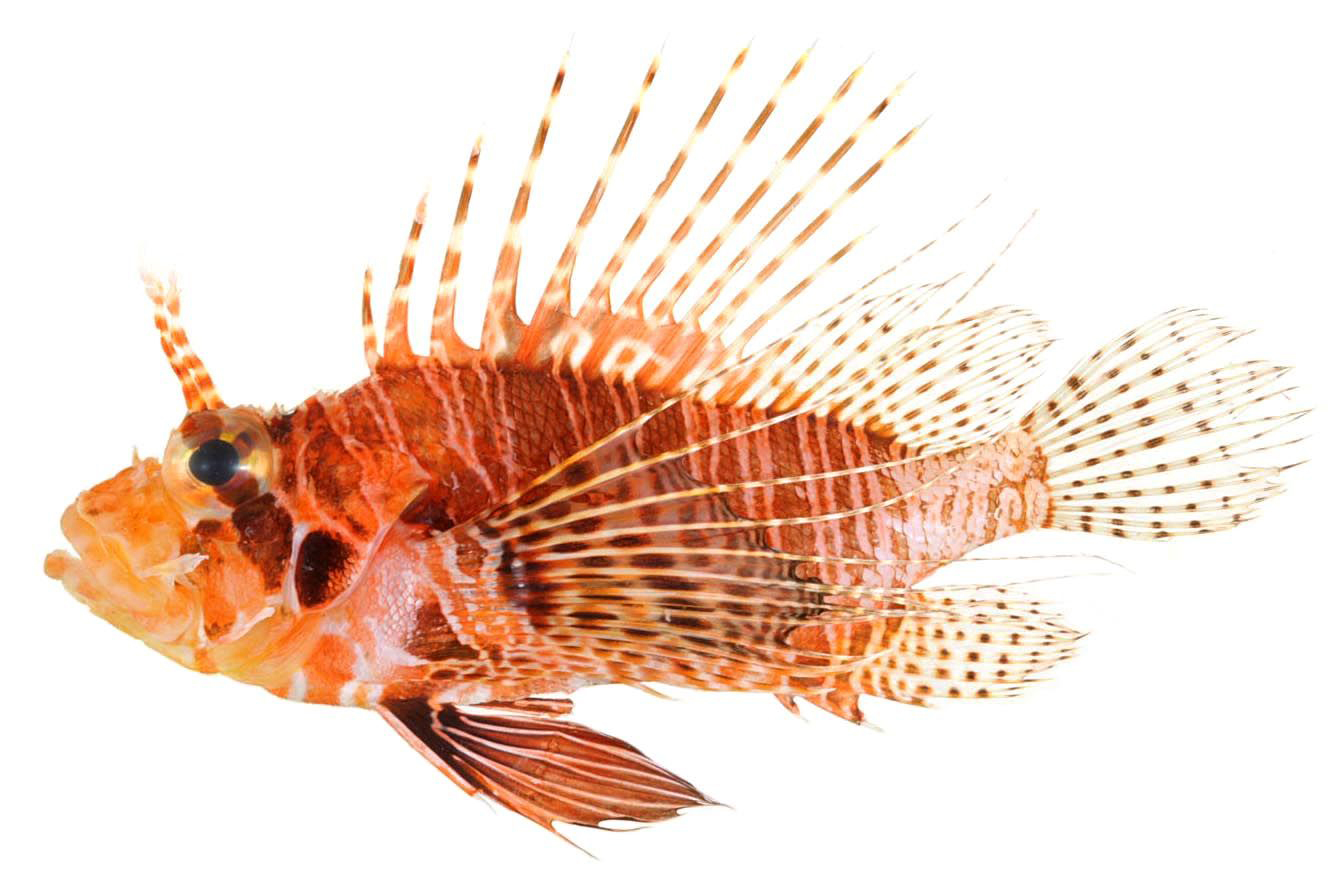- Classification
- ACTINOPTERYGII
- SCORPAENIFORMES
- SCORPAENIDAE
- Pterois
- paucispinula
Pterois paucispinula Matsunuma & Motomura 2014

Pterois paucispinula, from Moorea, French Polynesia - USNM 392530. Source: Jeffrey T. Williams / Smithsonian Institution, National Museum of Natural History, Department of Vertebrate Zoology, Division of Fishes. License: CC by Attribution-NonCommercial-ShareAlike
Summary:
A lionfish with 14–28 relatively large black blotches on pectoral-fin membrane, several bands on posterior portion of rays (not attached to membrane), and several narrow to wide vertical bands on body sides and caudal peduncle.
In Australia, Pterois paucispinula has previously been confused with Pterois mombasae.
In Australia, Pterois paucispinula has previously been confused with Pterois mombasae.
Cite this page as:
Bray, D.J. 2017, Pterois paucispinula in Fishes of Australia, accessed 27 Jun 2025, https://fishesofaustralia.net.au/Home/species/5135
Pterois paucispinula Matsunuma & Motomura 2014
More Info
|
Distribution |
Recorded in Australia from the Northwest Shelf, Western Australia, to the Timor Sea, northwest of Melville Island, Northern Territory. Found elsewhere in the tropical Western Pacific from northern Australia to southern Japan and eastward to the Wallis and Futuna Islands. usualy inhabits soft-bottom or muddy substrates with rubble areas amongst rich invertebrate growth, especially sponges. |
|
Features |
Meristic features: Dorsal fin XIII, 10-11 (rarely 11); Anal fin III, 6; Pectoral fin 17–19; Pelvic fin I, 5; Scale rows below lateral line 11–15; Branchiostegal rays 7. Body depth at anal-fin origin 26.0–32.8 (mean 30.2) % SL; head width 12.6–15.6 (14.4) % SL; postorbital length 15.4–20.0 (18.1) % SL; longest dorsal-fin spine length 42.9–51.7 (47.8) % SL; caudal-peduncle depth 9.9–11.9 (11.0) % SL; area of ctenoid scales on body relatively small (usually dorsolateral region only at ca. 90 mm SL, sometimes extending below lateral line onto ventrolateral region, and on pectoral-fin base and laterally on caudal peduncle in adults (80 mm SL) (Matsunuma & Motomura 2014). |
|
Colour |
Pinkish creamy-white (or white) with a broad white-margined reddish-black to black band through the eye, a large black blotch on the lower gill cover, 3 bands on nape, body sides with numerous broad reddish-brown to light brown bands (interspersed with narrower bands) extending slightly onto dorsal and anal fins, a moderately large black blotch above pectoral-fin base with a small white inner spot, 2–6 reddish-brown to blackish bands on spinous dorsal fins, numerous small black spots on soft dorsal, anal-and caudal-fin membranes, and 14–28 large reddish-black to black blotches on pectoral fin. |
|
Similar Species |
Differ from Pterois antennata in having relatively narrow bands on the body and more than 17 pectoral-fin rays. P. paucispinula also differs from P. antennata in having: dorsal-fin rays usually XIII, 10 (rarely XIII, 11) [vs. usually XII, 11 (rarely XII, 10 or XII, 12) in P. antennata]; pectoral-fin rays usually more than 18 (rarely 17) [vs. usually less than 17 (rarely 18)]; and several bands on the posterior portion of the upper pectoral-fin rays (free from membrane) (vs. bands absent). |
|
Etymology |
The specific name paucispinula is from Latin work meaning "few spines" in reference to the small number of spinules on the ctenoid scales found on the head and body, in contrast to the closely related P. mombasae. |
|
Species Citation |
Pterois paucispinula Matsunuma & Motomura, 2014, Ichthyol. Res DOI 10.1007/s10228-014-0451-6 Type locality: Kashiwa-jima Island, Kochi Prefecture, Japan. |
|
Author |
Bray, D.J. 2017 |
Pterois paucispinula Matsunuma & Motomura 2014
References
Allen, G.R. 1997. Marine Fishes of Tropical Australia and South-east Asia. Perth : Western Australian Museum 292 pp. 106 pls. [76, as Pterois mombasae]
Allen, G.R., N J. Cross, D.J. Bray & D.F. Hoese. 2006. Scorpaenidae. p. 876 in Beesley, P.L. & Wells, A. (eds). Zoological Catalogue of Australia. Volume 35 Australia : ABRS & CSIRO Publishing Parts 1-3, 2178 pp. (as Pterois mombasae)
Allen, G.R. & Swainston, R. 1988. The Marine Fishes of North-Western Australia. A field guide for anglers and divers. Perth, WA : Western Australian Museum vi 201 pp., 70 pls. [48, as Pterois mombasae]
Allen, G.R. Cross, N.J., Hoese, D.F. & Bray, D.J. 2006. Pteroinae. pp. 877-880 in Beesley, P.L. & Wells, A. (eds). Zoological Catalogue of Australia. Volume 35 Australia : ABRS & CSIRO Publishing Parts 1-3, 2178 pp. [879, as Pterois mombasae]
Fricke, R., Kulbicki, M. & Wantiez, L. 2011. Checklist of the fishes of New Caledonia, and their distribution in the Southwest Pacific Ocean (Pisces). Stuttgarter Beiträge zur Naturkunde. Serie A (Biologie) Neue Serie 4: 341-463. [378, as Pterois mombasae]
Gloerfelt-Tarp, T. & Kailola, P.J. 1984. Trawled Fishes of Southern Indonesia and Northwest Australia. Jakarta : Dir. Gen. Fish. (Indonesia), German Tech. Coop., Aust. Dev. Ass. Bur. 406 pp. (as Pterois mombasae)
Hutchins, J.B. 2001. Checklist of the fishes of Western Australia. Records of the Western Australian Museum, Supplement 63: 9-50 [27, as Pterois mombasae]
Kuiter, R.H. 1996. Guide to Sea Fishes of Australia. A comprehensive reference for divers and fishermen. Sydney, NSW, Australia : New Holland Publishers xvii, 434 pp. [90, as Pterois mombasae]
Matsunuma, M. & H. Motomura. 2014. Pterois paucispinula, a new species of lionfish (Scorpaenidae: Pteroinae) from the western Pacific Ocean. Ichthyological Research DOI 10.1007/s10228-014-0451-6
Poss, S.G. 1999. Families Scorpaenidae, Caracanthidae, Aploactinidae. pp. 2291-2358 in Carpenter, K.E. & Niem, T.H. (eds). The Living Marine Resources of the Western Central Pacific. FAO Species Identification Guide for Fisheries Purposes. Rome : FAO Vol. 4 2069-2790 pp. [2330, as Pterois mombasae]

